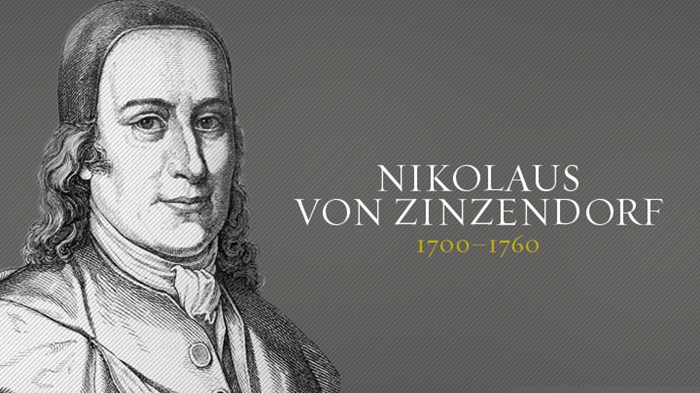
"There can be no Christianity without community."
Nearly two centuries after Luther posted his 95 Theses, Protestantism had lost some of its soul. Institutions and dogma had, in many people's minds, choked the life out of the Reformation.
Lutheran minister P.J. Spener hoped to revive the church by promoting the "practice of piety," emphasizing prayer and Bible reading over dogma. It worked. Pietism spread quickly, reinvigorating Protestants throughout Europe—including underground Protestants in Moravia and Bohemia (modern Czechoslovakia).
The Catholic church cracked down on the dissidents, and many were forced to flee to Protestant areas of neighboring Germany. One group of families fled north to Saxony, where they settled on the lands belonging to a rich young ruler, Count Nikolaus Ludwig von Zinzendorf.
Rich young ruler
Born into Austrian nobility and raised by his grandmother, Zinzendorf showed an early inclination toward theology and religious work. As the godson of P.J. Spener, he was raised in a strong Pietist tradition. But as a count, he was expected to follow his late father's footsteps into government. He did as he was told and in October 1721 became the king's judicial counselor at Dresden.
After less than a year at court, he bought the estate of Berthelsdorf from his grandmother, hoping to form a Christian community for oppressed religious minorities. Almost immediately a Moravian named Christian David showed up at his door and became his first tenant. Ten Moravian Protestants arrived before December and founded a settlement on the count's land. They named it Herrnhut—"the Lord's watch."
Timeline |
|
|
1668 |
Rembrandt paints Return of the Prodigal Son |
|
1675 |
SpenerÂ’s Pia Desideria advances Pietism |
|
1685 |
Edict of Potsdam grants asylum to Huguenots |
|
1700 |
Nikolaus von Zinzendorf born |
|
1760 |
Nikolaus von Zinzendorf dies |
|
1781 |
Kant publishes Critique of Pure Reason |
By May 1725, 90 Moravians were gathered at Herrnhut. Because of the spirited preaching at the Berthelsdorf parish church, the population of this "small city" had reached 300 by 1726.
The count was still a devout Lutheran and tried to keep the refugees within the parish church. His goal was to form ecclesiolae in ecclesia—"little churches within the church"—to act as a leaven, revitalizing and unifying churches into one communion. But with the diversity at Herrnhut, discord soon arose. When it did, Zinzendorf moved to Herrnhut with his family. He went from house to house counseling those who needed it and created a "Brotherly Agreement" of manorial rules. He also appointed watchmen, almoners, and other caretakers.
"There can be no Christianity without community," he said.
Getting serious
In July 1737 Zinzendorf accidentally discovered a copy of the constitution of the Unitas Fratrum (Unity of the Brethren) of the fifteenth-century Hussite movement in Bohemia and Moravia. He was amazed that the Unitas Fratrum was "a fully established church antedating Lutheranism itself." Even more amazing, the constitution was very similar to his newly adopted "Brotherly Agreement."
He raced back to Herrnhut to share his discovery, and at a powerful Communion service, the Moravians at Herrnhut vowed to restore the older church with Zinzendorf. The Berthelsdorf parish church would continue as a Lutheran parish, but became Herrnhut, a Unity of the Brethren congregation; they would later become known as the Moravian Church.
Like the Pietists, the Moravian Brethren believed that Christianity should be a "religion of the heart"—which went against the grain of the growing acceptance of Enlightenment beliefs. They emphasized experience of faith and love over doctrine, and thus were more accepting of varying denominational differences. In fact, Zinzendorf may have been the first churchman to use the word "ecumenism." The Moravians also placed special importance on community: families' allegiances were superseded by "choirs"—groups delineated by age, sex, and marital status.
The real missions father
Visiting Copenhagen in 1731 to attend the coronation of King Christian VI, Zinzendorf met a converted slave from the West Indies, Anthony Ulrich. The man was looking for someone to go back to his homeland to preach the gospel to black slaves, including his sister and brother. Zinzendorf raced back to Herrnhut to find men to go; two immediately volunteered, becoming the first Moravian missionaries—and the first Protestant missionaries of the modern era, antedating William Carey (often called "the father of modern missions") by 60-some years.
Within two decades, Zinzendorf sent missionaries around the globe: to Greenland, Lapland, Georgia, Surinam, Africa's Guinea Coast, South Africa, Amsterdam's Jewish quarter, Algeria, the native North Americans, Ceylon, Romania, and Constantinople. In short order, more than 70 missionaries from a community of fewer than 600 answered the call.
By the time Zinzendorf died in 1760 in Herrnhut, the Moravians had sent out at least 226 missionaries.
Zinzendorf's influence is felt much wider than in the Moravian Church. His emphasis on the "religion of the heart" deeply influenced John Wesley. He is remembered today, as Karl Barth put it, as "perhaps the only genuine Christocentric of the modern age." Scholar George Forell put it more succinctly: Zinzendorf was "the noble Jesus freak."

Support Our Work
Subscribe to CT for less than $4.25/month


























